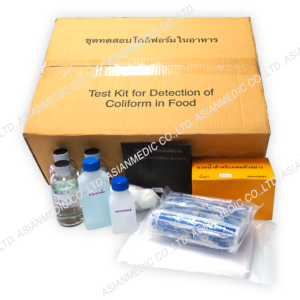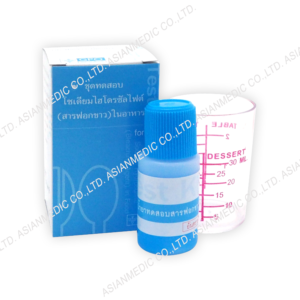Principles
It is a test method for organochlorine and pyrethroid pesticide in vegetable, fruits, cereals and grain.
It uses TLC separation principle and test by chemical reaction and expose to UV at wavelength of 254 nm to create colour, if there is organochlorine and pyrethroid pesticide grey , brown-black spot on the TLC sheet will occur.
Effectiveness of Test Kit
To detection of toxic residue Oganochlorine compound and pyrethroid, Cholinesterase inhibitors reagent in food within 30-45 minutes
Detection limit 0.05 mg./Kg.
Specificity 100%
Sensitivity 83.8%
Accuracy 89.5%
Pesticides test kit for 2 group
Test / Kit 30 Test/ Kit
Shelf Life 12 Month
Keeping Below 8-26 C
Reagent
| 1 | Liquid extract (extraction) | 3 bottle |
| 2 | Liquid GPO-4 Solution | 3 bottle |
| 3 | Liquid GPO-5 Solution | 2 bottle |
| 4 | Liquid GPO-TM 5.1 Solution | 1 bottle |
Equipment in Box :
| 1 | TLC sheet | 6 set |
| 2 | Bulb glass dropper (capillary tube) | 30 pc |
| 3 | plastic dropper 3 ml | 2 pc |
| 4 | Plastic dropper 1 ml | 1 pc |
| 5 | Instruction manual | 1 pc |
Additional Equipment Required :
- Water bath temperature at 48±2C include sieve
- UV box (UV 254 nm)
- Bottle soaked sheet (TLC tank)
- Cups metal
- Bottle for sample and dropper
- Butcher knife for slicing sample
- Tweezers (forcept)
- Tray for placing TLC sheet
- Gloves
- Timer
Test Solution Preparation
Drow 10 ml GPO-5 solution and 2 ml liquid volume GPO- TM 5.1 into the TLC tank. Shake well and let it sits for at least 30 minute before the test
Test Procedure
Sample preparation and Extraction
Chop vegetables and fruits thoroughly. Put them into the bottle of approximately 5 grams or 4 lines on the bottle, in case of whole grains, use about 2.5 grams or 2 line on the bottle. Label every sample bottle
.Use a dropper to drown 5 ml of the extraction in to the sample bottle. Shake sturdily for 1 minute and let it sit for 5 minute
Evaporation
Use the plastic dropper to drown 1 ml of the clear extraction in 1.2 into the metal cup which is placed on the sieve. Leave the sieve in the water bath at 48±C. Wait until liquid extract in a metal cup is almost all evaporated or is about 2 drops left
TLC Sheet Preparation
Write the sample ID on the TLC sheet. Do not touch the TLC sheet directly with your hands.This will create grease on the sheet and interfere the test.
Use a pencil to mark a spot in the middle of each column. This is the spot to drop the extraction. It is 1.5 cm measured from the bottom of the sheet.
The highest level where the solution can move is 8.5 cm measured from the bottom of the sheet. Mark the level lightly with a pencil
The remaining area from the marked level where the solution can move, write the sample and standard ID
Testing
Use the capillary tube to draw the sample extraction in 2 (if the solution in the metal cup are dried, drop 2 drops of the extraction in to the cup). Drop all the extraction by touching the tip of the capillary tube to the marked extraction dropping spot on the TLC sheet. Raise the capillary up and wait until the dropper extraction dried. Repeated about 4-6 times until the extraction runs out
Take TLC sheet and dip in to the TLC tank. Lean into the side of the bottle and close the lid (DO not shake or move the bottle)
When the solution moves to the specified level, open the lid and use the forecept to grip the TLC sheet. Place it on the side of the bottle and let it dry
Testing
Spray the TLC sheet with GPO-4 with distance 4-5 inches until it soaks. Let it to dry (1 minute)
Expose the TLC sheet with UV at the wavelength of 254 nm for 3-5 minute ( if expose to long, the sheet will be burn). If there is organochlorine and pyrethroid pesticide, it will turn grey, brown black. Read the color comparing result and Rf of the standard pesticides.
Interpretation
Positive found grey, brown-black spot on the TLC sheet. This shows that there is organochlorine and pyrethroid pesticide.
Negative no spot on the TLC sheet was found. This shows there is organochlorine and pyrethroid pesticide.
The Result Reading (OC &P)
| Listing standard | LOD (mg/kg) | Rf Standard |
| Cypemethrin | 3.1 | 0.5,0.53,0.58 |
| Permetrin | 1.9 | 0.71,0.83 |
| Deltametrin | 2.2 | 0.91 |
| Endrin | 0.3 | 0.82 |
| Endosulfan | 0.73 | 0.89 |
| DDT | 0.19 | 0.94 |















